Greece, Southern Style
Posted on May 2, 2016 by bob in Travel
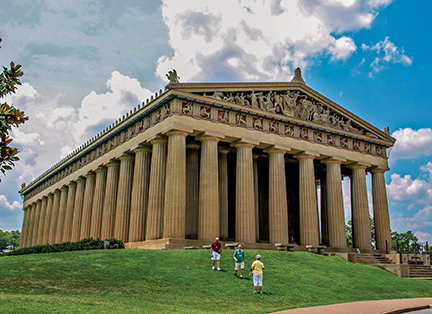
The Nashville Parthenon is a near-exact replica of the one built in Greece in the fifth century BC.
by Andrea Gross; photos by Irv Green
It’s an eye-popping, head-scratching sight. There, right in the middle of middle America, stands one of the most recognizable buildings in Europe: the Greek Parthenon, generally considered one of the wonders of the Ancient World. What in the name of Zeus is this historic monument doing in Nashville, Tennessee?
The Tennessee building is a replica, but looks much more like the temple where Socrates and Plato debated the merits of
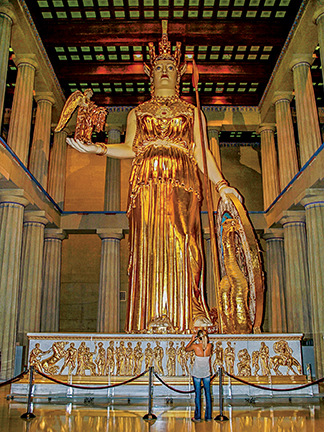
The statue of Athena, goddess of wisdom and prudent warfare, is 42 feet tall.
democracy than does the one in Athens. The original Parthenon, built in the fifth century B.C., shows its age. Some of the columns have crumbled; most of the roof is gone, and the marble sculptures that decorated its exterior are now in the British Museum of London, the center of a longstanding dispute between England and Greece. What’s more, the giant statue of Athena, which was created by Pheidias, the most famous sculptor of his time, disappeared 1,500 years ago. In contrast, the building in Nashville is in perfect condition.
My husband and I are awed by the 50 graceful Doric columns, which, like the original, are ingeniously tapered so that to the eye they appear straight while they actually tilt slightly inward, an architectural trick to make them appear regally tall.
Inside we’re mesmerized by a 42-foot tall statue of Athena, reproduced by Nashville sculptor Alan LeQuire. The goddess of wisdom and prudent warfare, whom the Parthenon was built to honor, is attired in a flowing gown and gilded with eight pounds of 23.75 carat gold. In her right hand she holds an adult-size statue of Nike, the goddess of victory.
In short, Nashville’s Parthenon resembles the original as it was, not as it is. This, of course, gets us back to our original question: Why Nashville?
Why wasn’t such a monument built in a city like Tarpon Springs, Florida, where more than ten percent of the population traces its ancestry back to Greece? Nashville doesn’t even rank in the top seventy largest Greek-American communities.
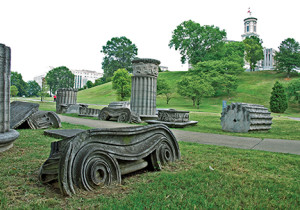
Fragments of pillars lie near the Tennessee State Capitol, giving visitors the feel as if they are wandering among Greek ruins.
The answer dates back to the mid-1800s, when the city was known as a center of wisdom, art and learning. It was the first city in the South to have a public school system, and it had more colleges and universities than other cities of its size. Proud Nashvillians said that in their reverence for knowledge and love of philosophical debate, they and the ancient Greeks were kindred spirits.
In addition to thinking like the Greeks, the city had a Greek flair due to its abundance of Greek Revival architecture. Citizens were inordinately proud of its buildings, many of which were graced with stately colonnades and porticos. Nashville became known as “The Athens of the South.”
Thus, in 1897 when it was asked to erect a pavilion for the state’s Centennial Exposition, it seemed natural to build a life-sized model of the Parthenon. The building was only intended to last for the six-month duration of the Exposition, but the citizens balked at tearing it down. Instead, they replaced the temporary structure with a permanent one, which was completed in 1931.
Today the Nashville Parthenon serves as the city’s art museum and houses a permanent collection of paintings by 19th and 20th century American artists. Other galleries are used for temporary exhibits. In addition, it hosts a series of free educational programs that range from panel discussions to formal lectures.
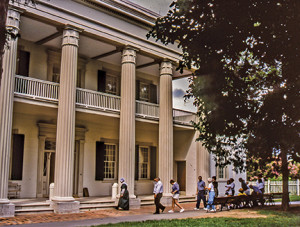
The Hermitage, home of President Andrew Jackson, is an example of classical Greek architecture.
As for Nashville’s Greek atmosphere, its streets are still filled with fine examples of classical Greek architecture. Not far from the Parthenon, the Tennessee State Capitol, modeled after a Greek temple, sits atop Nashville’s own acropolis.
In 1955 the capitol, which was then nearly 100 years old, needed a fix-up. We drive to the north side of the building where we find some of the original pillars that weren’t used in the restoration. They’re scattered on a small patch of grass, where they bear an eerie resemblance to the ruins of ancient Greece.
Later we explore the area near West End Avenue and Belle Meade Boulevard, where many homes have the trademark Greek columns and porticos. The most famous of the Greek Revival homes belonged to Andrew Jackson, the seventh president of the United States. His home, The Hermitage, was originally built in the Federal style, but after being destroyed by fire, it was rebuilt with the classical elements that were more in vogue at the time. A smaller home, Tulip Grove, on the outskirts of Jackson’s estate, provides an even better example of the Greek style.
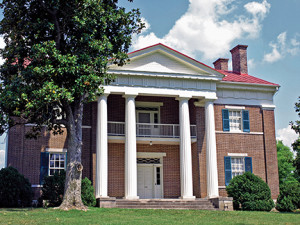
Tulip Grove, on the grounds of Jackson’s estate, also has elements of Greek style.
Finally, we go to the Athens Family Restaurant. It’s housed in an architecturally bland building but is renowned for its authentically spiced Greek food, including gyros and souvlaki. Of course, in what is altogether fitting for the culture that practically invented democracy, the chefs also serve thoroughly American hamburgers!
For more information on Tennessee and other exciting destinations, visit www.traveltizers.com.









